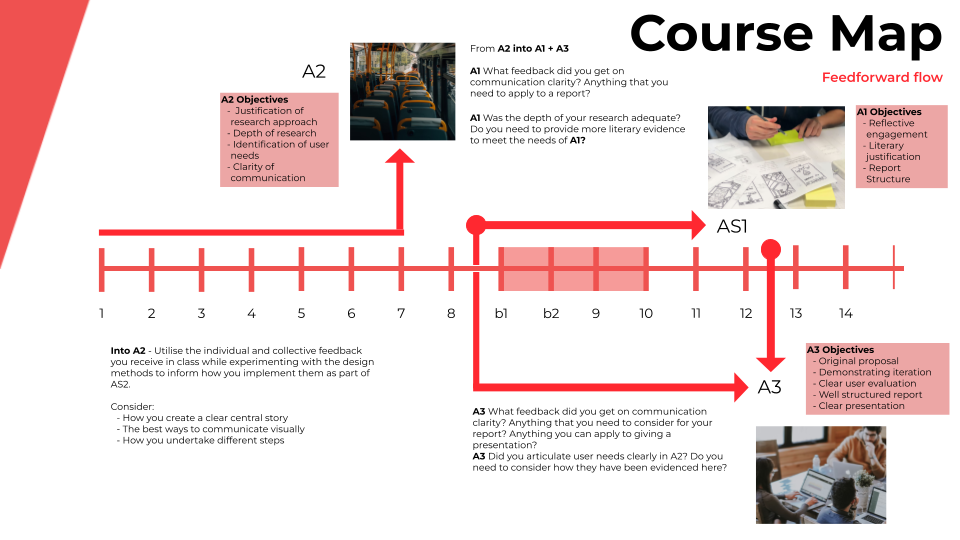I recently posted about the importance of feedback being oriented towards giving learners advice about the very next thing that they need to work on. This can be achieved by giving them just a few key points of feedforward for the next assignment.
In order to do this we need to keep in mind, when marking one assignment, what the nature and assessment criteria are the next assignment is, so that we can make the advice we give the most relevant. If you are thinking that feels like a lot of cognitive load to deal with in the moment of actually giving the feedback, you would be right. This would also be difficult or even impossible for members of a teaching team that are teaching a course for the first time.
For this reason, mapping out the feedforward flows and connections as a document can help to provide guidance to those giving feedback and reduce the cognitive load. I’ve found it to be a lower load than providing regular feedback because you can focus around just a few key nodes of interest.
Note that I’ve used the term ‘feedforward’ throughout this post – while feedback and feedforward are advertised like they are separate processes, I’d suggest that they are in fact the same. Providing useful information for the future has always been the point of feedback, but it is an aspect that has oft been forgotten in the doing of it. Rebranding the process as ‘feedforward’ just helps to give emphasis and remind us of this important focus. If you are doing either one right, then they’re the same thing.
Building your feedforward nodes
I have a suggestion for building this map:
- Make three columns
- Take a moment to write down the assignment criteria/rubric elements for one assignment in the left hand column
- Do the same for the following assignment(s) in the right most column
Question and note the following in the central column:
- Where are the connections in between?
- What are the elements that feed in to one another?
- What criteria, if performed poorly, would need to be corrected so that learners have a chance of hitting a specific grade level better next time? How can you draw this as a direct line for learners?
For example, is there an overlapping need focussed towards communication and the clear presentation of ideas or arguments? If so, you know that this is something that you can have as a key node in the feedback you give. If they performed well in relation to this you can provide positive reinforcement and highlight where similar attention will be required for specific attributes of the following assignment(s). If they have not been successful at that aspect you can provide guidance on what they should specifically be doing to address this and what it would look more like as part of the next assignment.
Ultimately you can have in mind a just a small handful of key nodes that you can comment in relation to within your moment of feedforward and this means that you don’t need to hold both sets (or even multiple sets) of criteria in mind in order to balance them on the fly. So while the marking of an assignment responds to the rubric (this is its purpose), the feedforward should really focus on this moment of bridging between the two assignments and their success criteria.
A map for student agency
This map can also be shown to students as a framework to work through their feedback and draw out their own points that they can use to direct subsequent assignments. With this as the case you could pose your nodes as reflective questions like: “Assignment 2 has an assessment criteria in relation to ‘communication and the clear presentation of ideas or arguments’. What feedback have you received in assignment 1 that connects to this?” Helping students to ask themselves these questions will aid in the creation of feedback agency and hopefully give them practices that they will employ without direct guidance.
What might this map look like? I have a couple of examples that i built as part of my recent teaching.
Map 1: Simply the steps
The first one is very simple. It highlights the stepping transitions between assessments and provides guidance on what learners should be paying attention to leading into and out of assignments.

Map 2: More complex
The second is more complex and is more extensively built around the prompt questions mentioned above. It also tries to consider how the first assignment can provide feedforward to multiple different following assignments.

Shifting the weight of interpretation
Ultimately, why focussing on the nodes which connect assignments holds so much value is because it takes off a bunch of the load of interpretation from learners. This interpretation of what changes in implementation/practice would look like is actually quite easy for us as teachers to highlight, especially when we can tie it down to a specific instance of how it would appear as part of the next assignment.
Learners, who are still very much building their understanding of the discipline and their feedback agency may find this particular task challenging. Providing feedback using these mapping methods gives them something more actionable and will be greatly appreciated as part of their learning experience.

Love this! What a great opportunity to also align module content to upcoming assessment. Will use this in our assessment mapping, thanks Marty!